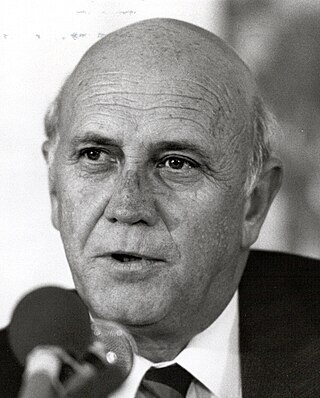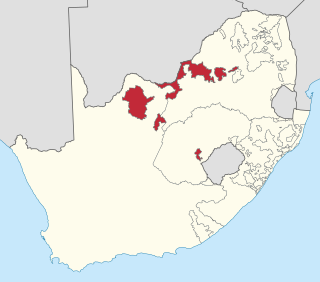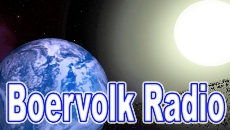
Frederik Willem de Klerk was a South African politician who served as state president of South Africa from 1989 to 1994 and as deputy president from 1994 to 1996. As South Africa's last head of state from the era of white-minority rule, he and his government dismantled the apartheid system and introduced universal suffrage. Ideologically a social conservative and an economic liberal, he led the National Party (NP) from 1989 to 1997.

The Truth and Reconciliation Commission (TRC) was a court-like restorative justice body assembled in South Africa in 1996 after the end of apartheid. Authorised by Nelson Mandela and chaired by Desmond Tutu, the commission invited witnesses who were identified as victims of gross human rights violations to give statements about their experiences, and selected some for public hearings. Perpetrators of violence could also give testimony and request amnesty from both civil and criminal prosecution.

Bophuthatswana, officially the Republic of Bophuthatswana, was a Bantustan that was declared (nominally) independent by the apartheid regime of South Africa in 1977. However, its independence, like the other Bantustans of Ciskei, Transkei and Venda was not recognized by any country other than South Africa.

The Afrikaner Weerstandsbeweging, meaning "Afrikaner Resistance Movement", commonly known by its abbreviation AWB, is an Afrikaner nationalist, neo-Nazi political party in South Africa. Since its founding in 1973 by Eugène Terre'Blanche and six other far-right Afrikaners, it has been dedicated to secessionist Afrikaner nationalism and the creation of an independent Boer-Afrikaner republic or "Volkstaat/Boerestaat" in part of South Africa. During bilateral negotiations to end apartheid in the early 1990s, the organisation terrorised and killed black South Africans.

Eugène Ney Terre'Blanche was an Afrikaner nationalist who founded and led the Afrikaner Weerstandsbeweging. Prior to founding the AWB, he served as a South African Police officer, was a farmer, and was an unsuccessful Herstigte Nasionale Party candidate for local office in the Transvaal. He was a major figure in the right-wing backlash against the collapse of apartheid. His beliefs and philosophy have continued to be influential amongst white supremacists in South Africa and across the world.

Ventersdorp is a town of 4,200 in Dr Kenneth Kaunda District Municipality, North West Province, South Africa. It was the seat of the defunct Ventersdorp Local Municipality until 2016.
1994 in South Africa saw the transition from South Africa's National Party government who had ruled the country since 1948 and had advocated the apartheid system for most of its history, to the African National Congress (ANC) who had been outlawed in South Africa since the 1950s for its opposition to apartheid. The ANC won a majority in the first multiracial election held under universal suffrage. Previously, only white people were allowed to vote. There were some incidents of violence in the Bantustans leading up to the elections as some leaders of the Bantusans opposed participation in the elections, while other citizens wanted to vote and become part of South Africa. There were also bombings aimed at both the African National Congress and the National Party and politically-motivated murders of leaders of the opposing ANC and Inkatha Freedom Party (IFP).
The following lists events that happened during 1991 in South Africa.
The Leader, His Driver and the Driver's Wife is a 1991 British feature-length documentary film set during the final days of apartheid in South Africa, particularly centring on Eugène Terre'Blanche, founder and leader of the far-right Afrikaner Weerstandsbeweging (AWB). The film was directed by Nick Broomfield and first shown in 1991. It received an average of 2.3 million viewers during its screening on Channel 4. A year later it was the subject of legal action brought by the journalist, Jani Allan, in what was described as "the libel case of the summer". In 2006, Broomfield released a follow-up, His Big White Self.

The Herstigte Nasionale Party is a South African political party which was formed as a far-right splinter group of the now defunct National Party in 1969. The party name was commonly abbreviated as HNP, evoking the Herenigde Nasionale Party, although colloquially they were also known as the Herstigtes. The party is, unlike other splinter factions from the National Party, still active but politically irrelevant.
The 2002 Soweto bombings were a string of terrorist attacks that occurred in Soweto in South Africa's Gauteng province. Eight blasts took place on 30 October 2002, leaving one woman dead and her husband severely injured. One of the blasts severely damaged a mosque, while others targeted railways and petrol stations in the area. SAPS prevented one blast. Another bomb later detonated outside the Nan Hua Buddhist temple in Bronkhorstspruit, east of Pretoria. A white supremacist group, the Warriors of the Boer Nation, claimed responsibility for these explosions in a message sent to an Afrikaans newspaper.

A referendum on ending apartheid was held in South Africa on 17 March 1992. The referendum was limited to white South African voters, who were asked whether or not they supported the negotiated reforms begun by State President F. W. de Klerk two years earlier, in which he proposed to end the apartheid system that had been implemented since 1948. The result of the election was a large victory for the "yes" side, which ultimately resulted in apartheid being lifted. Universal suffrage was introduced two years later.
His Big White Self is a 2006 documentary film made by Nick Broomfield. It is a sequel to his earlier documentary The Leader, His Driver and the Driver's Wife (1991). It was first shown as part of More4's Nick Broomfield week which began on 27 February 2006. The documentary follows Broomfield as he returns to South Africa 12 years after the final end of the apartheid regime. His previous film focused largely on JP Meyer, a driver for Eugène Terre'Blanche, and JP's wife, Anita.

Afrikaner nationalism is a nationalistic political ideology created by Afrikaners residing in Southern Africa during the Victorian era. The ideology was developed in response to the significant events in Afrikaner history such as the Great Trek, the First and Second Boer Wars and the resulting anti-British sentiment that developed among Afrikaners and opposition to South Africa's entry into World War I.
The storming of the Kempton Park World Trade Centre took place in South Africa on 25 June 1993 when approximately three thousand members of the Afrikaner Volksfront (AVF), Afrikaner Weerstandsbeweging (AWB) and other right-wing Afrikaner paramilitary groups stormed the World Trade Centre in Kempton Park, near Johannesburg.

The 1994 Bophuthatswana crisis was a major political crisis which began after Lucas Mangope, the president of Bophuthatswana, a nominally independent South African bantustan created under apartheid, attempted to crush widespread labour unrest and popular demonstrations demanding the incorporation of the territory into South Africa pending non-racial elections later that year. Violent protests immediately broke out following President Mangope's announcement on 7 March that Bophuthatswana would boycott the South African general elections. This was escalated by the arrival of right-wing Afrikaner militias seeking to preserve the Mangope government. The predominantly black Bophuthatswana Defence Force and police refused to cooperate with the white extremists and mutinied, then forced the Afrikaner militias to leave Bophuthatswana. The South African military entered Bophuthatswana and restored order on 12 March.

The White Liberation Movement was a small but notorious South African neo-Nazi organisation which became infamous after being banned under the Apartheid regime, the first right-wing organisation to be so banned. It regarded itself as the most far-right organisation in South Africa.

Boervolk Radio presented by the Transvaal Separatists, is an internet-only radio station based in Kempton Park, South Africa.
Chris Hani, General-Secretary of the South African Communist Party (SACP), was assassinated by right-wing extremist Janusz Waluś on 10 April 1993. The assassination, later tied to members within the Conservative Party, occurred outside Hani's home in Dawn Park during a peak period of progressive anti-apartheid momentum in South Africa. After the assassination, racially fuelled riots drew international attention to the instability of the political division within South Africa, leading to an inclusive national democratic election in April 1994, won by the African National Congress (ANC). Waluś and his accomplice Clive Derby-Lewis were sentenced to death after their arrest in 1993; the sentence was later commuted to life imprisonment.
"Dubul' ibhunu", translated as shoot the Boer, as kill the Boer or as kill the farmer, is a controversial anti-apartheid South African song. It is sung in Xhosa or Zulu. The song originates in the struggle against apartheid when it was first sung to protest the Afrikaner dominated apartheid government of South Africa.












